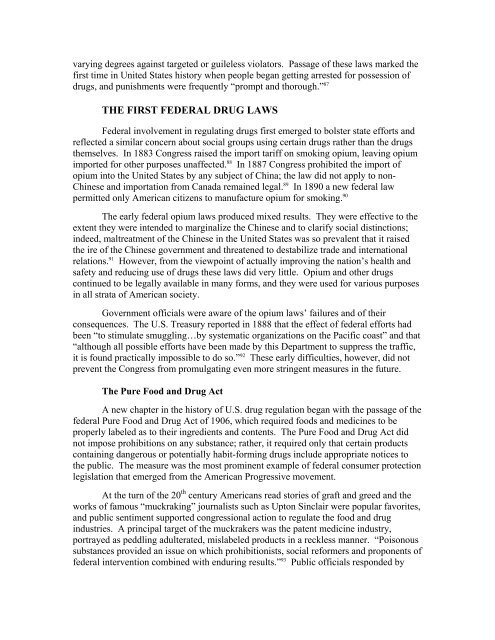Effective Drug Control: Toward A New Legal Framework
Effective Drug Control: Toward A New Legal Framework
Effective Drug Control: Toward A New Legal Framework
Create successful ePaper yourself
Turn your PDF publications into a flip-book with our unique Google optimized e-Paper software.
varying degrees against targeted or guileless violators. Passage of these laws marked the<br />
first time in United States history when people began getting arrested for possession of<br />
drugs, and punishments were frequently “prompt and thorough.” 87<br />
THE FIRST FEDERAL DRUG LAWS<br />
Federal involvement in regulating drugs first emerged to bolster state efforts and<br />
reflected a similar concern about social groups using certain drugs rather than the drugs<br />
themselves. In 1883 Congress raised the import tariff on smoking opium, leaving opium<br />
imported for other purposes unaffected. 88 In 1887 Congress prohibited the import of<br />
opium into the United States by any subject of China; the law did not apply to non-<br />
Chinese and importation from Canada remained legal. 89 In 1890 a new federal law<br />
permitted only American citizens to manufacture opium for smoking. 90<br />
The early federal opium laws produced mixed results. They were effective to the<br />
extent they were intended to marginalize the Chinese and to clarify social distinctions;<br />
indeed, maltreatment of the Chinese in the United States was so prevalent that it raised<br />
the ire of the Chinese government and threatened to destabilize trade and international<br />
relations. 91 However, from the viewpoint of actually improving the nation’s health and<br />
safety and reducing use of drugs these laws did very little. Opium and other drugs<br />
continued to be legally available in many forms, and they were used for various purposes<br />
in all strata of American society.<br />
Government officials were aware of the opium laws’ failures and of their<br />
consequences. The U.S. Treasury reported in 1888 that the effect of federal efforts had<br />
been “to stimulate smuggling…by systematic organizations on the Pacific coast” and that<br />
“although all possible efforts have been made by this Department to suppress the traffic,<br />
it is found practically impossible to do so.” 92 These early difficulties, however, did not<br />
prevent the Congress from promulgating even more stringent measures in the future.<br />
The Pure Food and <strong>Drug</strong> Act<br />
A new chapter in the history of U.S. drug regulation began with the passage of the<br />
federal Pure Food and <strong>Drug</strong> Act of 1906, which required foods and medicines to be<br />
properly labeled as to their ingredients and contents. The Pure Food and <strong>Drug</strong> Act did<br />
not impose prohibitions on any substance; rather, it required only that certain products<br />
containing dangerous or potentially habit-forming drugs include appropriate notices to<br />
the public. The measure was the most prominent example of federal consumer protection<br />
legislation that emerged from the American Progressive movement.<br />
At the turn of the 20 th century Americans read stories of graft and greed and the<br />
works of famous “muckraking” journalists such as Upton Sinclair were popular favorites,<br />
and public sentiment supported congressional action to regulate the food and drug<br />
industries. A principal target of the muckrakers was the patent medicine industry,<br />
portrayed as peddling adulterated, mislabeled products in a reckless manner. “Poisonous<br />
substances provided an issue on which prohibitionists, social reformers and proponents of<br />
federal intervention combined with enduring results.” 93 Public officials responded by
















